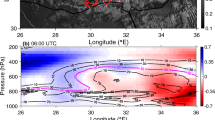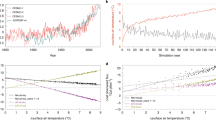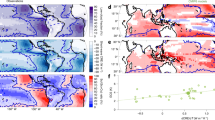Abstract
Stratocumulus clouds cover 20% of the low-latitude oceans and are especially prevalent in the subtropics. They cool the Earth by shading large portions of its surface from sunlight. However, as their dynamical scales are too small to be resolvable in global climate models, predictions of their response to greenhouse warming have remained uncertain. Here we report how stratocumulus decks respond to greenhouse warming in large-eddy simulations that explicitly resolve cloud dynamics in a representative subtropical region. In the simulations, stratocumulus decks become unstable and break up into scattered clouds when CO2 levels rise above 1,200 ppm. In addition to the warming from rising CO2 levels, this instability triggers a surface warming of about 8 K globally and 10 K in the subtropics. Once the stratocumulus decks have broken up, they only re-form once CO2 concentrations drop substantially below the level at which the instability first occurred. Climate transitions that arise from this instability may have contributed importantly to hothouse climates and abrupt climate changes in the geological past. Such transitions to a much warmer climate may also occur in the future if CO2 levels continue to rise.
This is a preview of subscription content, access via your institution
Access options
Access Nature and 54 other Nature Portfolio journals
Get Nature+, our best-value online-access subscription
$29.99 / 30 days
cancel any time
Subscribe to this journal
Receive 12 print issues and online access
$259.00 per year
only $21.58 per issue
Buy this article
- Purchase on Springer Link
- Instant access to full article PDF
Prices may be subject to local taxes which are calculated during checkout




Similar content being viewed by others
Code availability
The source code for the simulations is available at climate-dynamics.org/software/#pycles.
Data availability
The authors declare that the data supporting the findings of this study are available within the article and its Supplementary Information files. The raw data in the figures are available from the corresponding author upon request.
References
Wood, R. Stratocumulus clouds. Mon. Weather Rev. 140, 2373–2423 (2012).
Bretherton, C. S. & Wyant, M. C. Moisture transport, lower-tropospheric stability, and decoupling of cloud-topped boundary layers. J. Atmos. Sci. 54, 148–167 (1997).
Stevens, B. et al. On entrainment rates in nocturnal marine stratocumulus. Q. J. R. Meteorol. Soc. 129, 3469–3493 (2003).
Stevens, B. et al. Evaluation of large-eddy simulations via observations of nocturnal marine stratocumulus. Mon. Weather Rev. 133, 1443–1462 (2005).
Stevens, B. et al. On the structure of the lower troposphere in the summertime stratocumulus regime of the northeast Pacific. Mon. Weather Rev. 135, 985–1005 (2007).
Mellado, J. P. Cloud-top entrainment in stratocumulus clouds. Annu. Rev. Fluid. Mech. 49, 145–169 (2016).
Schneider, T. et al. Climate goals and computing the future of clouds. Nat. Clim. Change 7, 3–5 (2017).
Nam, C., Bony, S., Dufresne, J.-L. & Chepfer, H. The ‘too few, too bright’ tropical low-cloud problem in CMIP5 models. Geophys. Res. Lett. 39, L21801 (2012).
Lin, J.-L., Qian, T. & Shinoda, T. Stratocumulus clouds in Southeastern Pacific simulated by eight CMIP5–CFMIP global climate models. J. Clim. 27, 3000–3022 (2014).
Boucher, O. et al. in Climate Change 2013: The Physical Science Basis (eds Stocker, T. F. et al.) Ch. 7 (IPCC, Cambridge Univ. Press, 2013).
Eastman, R., Warren, S. G. & Hahn, C. J. Variations in cloud cover and cloud types over the ocean from surface observations, 1954–2008. J. Clim. 24, 5914–5934 (2011).
Vial, J., Dufresne, J.-L. & Bony, S. On the interpretation of inter-model spread in CMIP5 climate sensitivity estimates. Clim. Dyn. 41, 3339–3362 (2013).
Webb, M. J., Lambert, F. H. & Gregory, J. M. Origins of differences in climate sensitivity, forcing and feedback in climate models. Clim. Dyn. 40, 677–707 (2013).
Seneviratne, S. I., Donat, M. G., Pitman, A. J., Knutti, R. & Wilby, R. L. Allowable CO2 emissions based on regional and impact-related climate targets. Nature 529, 477–483 (2016).
Blossey, P. N. et al. Marine low cloud sensitivity to an idealized climate change: the CGILS LES intercomparison. J. Adv. Model. Earth Syst. 5, 234–258 (2013).
Zhang, M. et al. CGILS: results from the first phase of an international project to understand the physical mechanisms of low cloud feedbacks in general circulation models. J. Adv. Model. Earth Syst. 5, 826–842 (2013).
Bretherton, C. S., Blossey, P. N. & Jones, C. R. Mechanisms of marine low cloud sensitivity to idealized climate perturbations: a single-LES exploration extending the CGILS cases. J. Adv. Model. Earth Syst. 5, 316–337 (2013).
Bretherton, C. S. & Blossey, P. N. Low cloud reduction in a greenhouse-warmed climate: results from Lagrangian LES of a subtropical marine cloudiness transition. J. Adv. Model. Earth Syst. 6, 91–114 (2014).
Bretherton, C. S. Insights into low-latitude cloud feedbacks from high-resolution models. Phil. Trans. R. Soc. Lond. A 373, 20140415 (2015).
Pressel, K. G., Kaul, C. M., Schneider, T., Tan, Z. & Mishra, S. Large-eddy simulation in an anelastic framework with closed water and entropy balances. J. Adv. Model. Earth Syst. 7, 1425–1456 (2015).
Pressel, K. G., Mishra, S., Schneider, T., Kaul, C. M. & Tan, Z. Numerics and subgrid-scale modeling in large eddy simulations of stratocumulus clouds. J. Adv. Model. Earth Syst. 9, 1342–1365 (2017).
Klein, S. A. & Hartmann, D. L. The seasonal cycle of low stratiform clouds. J. Clim. 6, 1587–1606 (1993).
Tan, Z., Schneider, T., Teixeira, J. & Pressel, K. G. Large-eddy simulation of subtropical cloud-topped boundary layers: 1. A forcing framework with closed surface energy balance. J. Adv. Model. Earth Syst. 8, 1565–1585 (2016).
Tan, Z., Schneider, T., Teixeira, J. & Pressel, K. G. Large-eddy simulation of subtropical cloud-topped boundary layers: 2. Cloud response to climate change. J. Adv. Model. Earth Syst. 9, 19–38 (2017).
Pierrehumbert, R. T. Thermostats, radiator fins, and the local runaway greenhouse. J. Atmos. Sci. 52, 1784–1806 (1995).
Sobel, A. H., Nilsson, J. & Polvani, L. M. The weak temperature gradient approximation and balanced tropical moisture waves. J. Atmos. Sci. 58, 3650–3665 (2001).
Flato, G. et al. in Climate Change 2013: The Physical Science Basis (eds Stocker, T. F. et al.) 741–853 (IPCC, Cambridge Univ. Press, 2013).
Loeb, N. G. et al. Clouds and the earth’s radiant energy system (CERES) energy balanced and filled (EBAF) top-of-atmosphere (TOA) edition-4.0 data product. J. Clim. 31, 895–918 (2018).
Christensen, M. W., Carrio, G. G., Stephens, G. L. & Cotton, W. R. Radiative impacts of free-tropospheric clouds on the properties of marine stratocumulus. J. Atmos. Sci. 70, 3102–3118 (2013).
Randall, D. A. & Suarez, M. J. On the dynamics of stratocumulus formation and dissipation. J. Atmos. Sci. 41, 3052–3057 (1984).
Bretherton, C. S., Uchida, J. & Blossey, P. N. Slow manifolds and multiple equilibria in stratocumulus-capped boundary layers. J. Adv. Model. Earth Syst. 2, 14 (2010).
Held, I. M. & Soden, B. J. Robust responses of the hydrological cycle to global warming. J. Clim. 19, 5686–5699 (2006).
Vecchi, G. A. & Soden, B. J. Global warming and the weakening of the tropical circulation. J. Clim. 20, 4316–4340 (2007).
Scheffer, M. et al. Early-warning signals for critical transitions. Nature 461, 53–59 (2009).
Huber, M. & Caballero, R. The early Eocene equable climate problem revisited. Clim. Past 7, 603–633 (2011).
Caballero, R. & Huber, M. State-dependent climate sensitivity in past warm climates and its implications for future climate projections. Proc. Natl Acad. Sci. USA 110, 14162–14167 (2013).
Kopp, R. E. et al. in Climate Science Special Report: Fourth National Climate Assessment Vol. I (eds Wuebbles, D. J. et al.) 411–429 (US Global Change Research Program, 2017).
Cramwinckel, M. J. et al. Synchronous tropical and deep-ocean temperature evolution in the Eocene. Nature 559, 382–386 (2018).
Anagnostou, E. et al. Changing atmospheric CO2 concentration was the primary driver of early Cenozoic climate. Nature 533, 380–384 (2016).
Liu, Z. et al. Global cooling during the Eocene–Oligocene climate transition. Science 323, 1187–1190 (2009).
Meinshausen, M. et al. The RCP greenhouse gas concentrations and their extensions from 1765 to 2300. Clim. Change 109, 213–241 (2011).
Jiang, G.-S. & Shu, C.-W. Efficient implementation of weighted ENO schemes. J. Comp. Phys. 126, 202–228 (1996).
Stevens, B. et al. Dynamics and chemistry of marine stratocumulus–DYCOMS-II. Bull. Am. Meteorol. Soc. 84, 579–593 (2003).
Matheou, G. Turbulence structure in a stratocumulus cloud. Atmosphere 9, 392 (2018).
Mellado, J. P., Bretherton, C. S., Stevens, B. & Wyant, M. C. DNS and LES for simulating stratocumulus: better together. J. Adv. Model. Earth Syst. 10, 1421–1438 (2018).
Shu, C.-W. & Osher, S. Efficient implementation of essentially non-oscillatory shock-capturing schemes. J. Comp. Phys. 77, 439–471 (1988).
Jones, C. R., Bretherton, C. S. & Pritchard, M. S. Mean-state acceleration of cloud-resolving models and large eddy simulations. J. Adv. Model. Earth Syst. 7, 1643–1660 (2015).
Iacono, M. J. et al. Radiative forcing by long-lived greenhouse gases: calculations with the AER radiative transfer models. J. Geophys. Res. 113, D13103 (2008).
Byun, D. W. On the analytical solutions of flux-profile relationships for the atmospheric surface layer. J. Appl. Meteorol. 29, 652–657 (1990).
Manabe, S. & Wetherald, R. T. Thermal equilibrium of the atmosphere with a given distribution of relative humidity. J. Atmos. Sci. 24, 241–259 (1967).
Akmaev, R. A. A direct algorithm for convective adjustment of the vertical temperature profile for an arbitrary critical lapse rate. Mon. Weather Rev. 119, 2499–2504 (1991).
Held, I. M. & Soden, B. J. Water vapor feedback and global warming. Annu. Rev. Energy Environ. 25, 441–475 (2000).
O’Gorman, P. A. & Schneider, T. The hydrological cycle over a wide range of climates simulated with an idealized GCM. J. Clim. 21, 3815–3832 (2008).
Schneider, T., O’Gorman, P. A. & Levine, X. J. Water vapor and the dynamics of climate changes. Rev. Geophys. 48, RG3001 (2010).
Sherwood, S. C. et al. Relative humidity changes in a warmer climate. J. Geophys. Res. 115, D09104 (2010).
Betts, A. K. & Ridgway, W. L. Climatic equilibrium of the atmospheric convective boundary layer over a tropical ocean. J. Atmos. Sci. 46, 2621–2641 (1989).
Trenberth, K. E. & Stepaniak, D. P. Seamless poleward atmospheric energy transports and implications for the Hadley circulation. J. Clim. 16, 3706–3722 (2003).
Kaul, C. M., Teixeira, J. & Suzuki, K. Sensitivities in large-eddy simulations of mixed-phase Arctic stratocumulus clouds using a simple microphysics approach. Mon. Weather Rev. 143, 4393–4421 (2015).
Straka, J. M. Cloud and Precipitation Microphysics: Principles and Parameterizations Ch. 4 (Cambridge Univ. Press, Cambridge, 2009).
Acknowledgements
This research was supported by C. Trimble. The computations were performed on ETH Zurich’s Euler cluster and on Caltech’s High Performance Cluster, which is partially supported by a grant from the Gordon and Betty Moore Foundation. We thank M. Hell for assistance with the figures. Part of this research was carried out at the Jet Propulsion Laboratory, California Institute of Technology, under a contract with the National Aeronautics and Space Administration.
Author information
Authors and Affiliations
Contributions
T.S. designed the study, analysed results, and wrote the paper. C.M.K. and K.G.P. implemented the study design numerically, conducted the LES, analysed and visualized the results, and contributed to the writing.
Corresponding author
Ethics declarations
Competing interests
The authors declare no competing interests.
Additional information
Publisher’s note: Springer Nature remains neutral with regard to jurisdictional claims in published maps and institutional affiliations.
Supplementary information
Supplementary Information
Supplementary Figures
Supplementary Movie
Time evolution of the stratocumulus instability. The shading shows the liquid water path in the subtropical LES domain in the 1300 ppm simulation between days 255 and 275, which is during the time of the stratocumulus breakup (Fig. 1). Blue for zero LWP, and the colorscale saturates white at a LWP of 300 μm. The time series at the bottom show the cloud fraction (blue) and SST (red) in the LES domain. The breakup of the stratocumulus clouds is more rapid than it would be in nature because of the unrealistically small thermal inertia of the underlying slab ocean.
Rights and permissions
About this article
Cite this article
Schneider, T., Kaul, C.M. & Pressel, K.G. Possible climate transitions from breakup of stratocumulus decks under greenhouse warming. Nat. Geosci. 12, 163–167 (2019). https://doi.org/10.1038/s41561-019-0310-1
Received:
Accepted:
Published:
Issue Date:
DOI: https://doi.org/10.1038/s41561-019-0310-1
This article is cited by
-
Harnessing AI and computing to advance climate modelling and prediction
Nature Climate Change (2023)
-
Cloud behaviour on tidally locked rocky planets from global high-resolution modelling
Nature Astronomy (2023)
-
Endophytic Fungi Improve Growth and Yield of Wheat (Triticum aestivum L.) Under Limited Light Conditions
Gesunde Pflanzen (2023)
-
Diversity in mitotic DNA repair efficiencies between commercial inbred maize lines and native Central American purple landraces
CABI Agriculture and Bioscience (2022)
-
Model spread in tropical low cloud feedback tied to overturning circulation response to warming
Nature Communications (2022)



